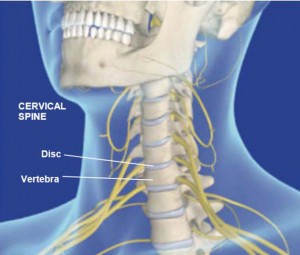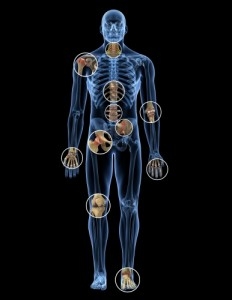Fibromyalgia, a common chronic pain condition, affects more than 5 million people in the United States. A poorly understood disorder, Fibromyalgia has been under diagnosed and under treated, but is thought to be the result of overactive nerves. Recent research also suggests that changes in the central nervous system (brain, spinal cord, and nerves) may be responsible. Fibromyalgia is characterized by widespread pain and tenderness, and is frequently associated with nervousness, irritability, anxiety, fatigue, depression, and insomnia. In addition symptoms may appear as chemical sensitivities, allergies, Restless Leg Syndrome, cold or burning hands and feet, and Irritable Bowel Syndrome.
Structural upper neck imbalances
One of the possible causes discovered by a growing number of physicians and researchers is structural upper neck imbalances. The greatest concentration of nerve connections in the human body is at the upper neck. Misalignment of the bones or inter vertebral discs in the cervical spine can result in nerve compression, which can affect the entire nervous system, and therefore, the whole body.
Various research has focused attention on the neurological conditions involving such compression of the upper portion of the spinal cord, with the University of Kansas School of Medicine and Arthritis Research Center studying the relationship between neck injury and Fibromyalgia. That study concluded that
Fibromyalgia occurred 13 times more frequently following a neck injury or condition that compresses the spinal cord, compared to injury to other areas of the body.
 Upper Cervical Stenosis
Upper Cervical Stenosis
It is not unusual to have Fibromyalgia along with spinal disorders. In fact, the National Fibromyalgia Research Association reports that 42 out of 45 Fibromyalgia sufferers displayed spinal cord compression. One condition that may result in Fibromyalgia-like symptoms is Upper Cervical Stenosis (USC), a narrowing of the spinal canal that can, over time, choke the spinal cord area. USC may be present as early as childhood, but various painful symptoms may take years, or even decades to develop before nerve compression becomes severe, through age-related spinal disc degeneration.
Treatment options
Two main treatment options are available for individuals with UCS: activity modification or cervical stenosis surgery. Individuals with less severe forms of this condition can modify their daily routines so as to avoid back injury. However, individuals with more severe cases of cervical stenosis require neck surgery to relieve pressure on the impacted nerves. In the case of Fibromyalgics, extensive open fusion surgery to repair damaged or injured discs is unthinkable. The pain of recovery, in addition to the damage done to already painful muscle tissue, leaves many unlikely candidates for traditional “open” instrumented fusion surgical techniques. However, minimally invasive surgical procedures exist that can repair damaged spinal discs through a small incision, usually the circumference of a dime, and without hospitalization, narcotic pain-management treatments, and lengthy physical therapy.
Source: bonati.com







